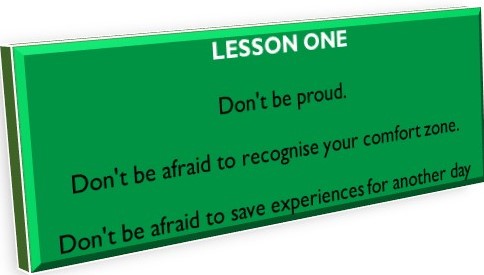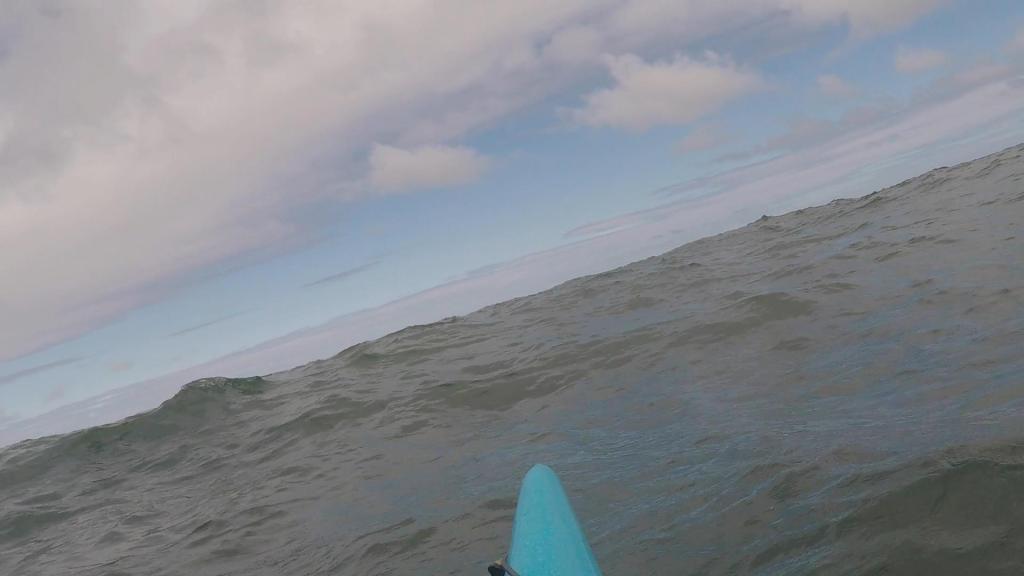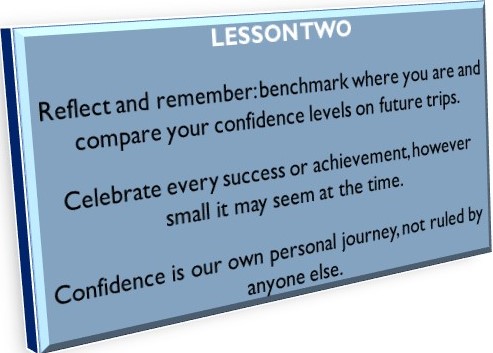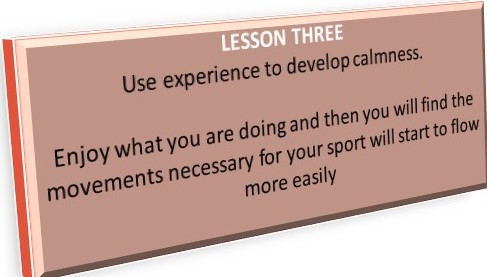It was a beautiful day and the promise of a trip along fabulously folded coastal cliffs with possible sightings of seals and a variety of seabirds was enticing.

We knew that it had been breezy and that we could expect onshore (westerly) winds (around 10-13 mph) for a paddle out of Ceibwr bay. It was no surprise then to have some rolling swell even in the bay on an incoming tide. What we found was rather more than that. As we neared the end of the bay I could see a line of bigger water: larger swell with some white tops. Not so long ago, I wouldn’t even have got this far; not so long ago I would have been afraid to make a turn on these waves; not so long ago my butterflies would have been more than fluttering, they would have been dialling my fear needle to ten. Nonetheless, the swell was choppy and I wasn’t prepared to go any further. It is one thing to pass through a short patch of difficult water, but this would have been relentless and I didn’t feel ready, or safe, to continue.
We turned back.

So, these waves were, on the plus side, not too muddled, they were pretty much rolling inshore in regular sets and weren’t breaking. The downside was that they had tops disturbed by wind and were about a metre and a half of swell. Not only was I disappearing into troughs but it was very much a case of ‘now you see me, now you don’t’ when trying to spot Christopher in his yellow boat. When I looked at stills from the video, it was also possible to see just how much the boat was rocking and tipping, so (once again) I was blessing the primary stability of the Scorpio which is never in a hurry to tip me out.
(Have a look at the video! https://youtu.be/MpxqsGHi4wY).

We headed back towards the shore and my nerves calmed, my muscles settled, the butterflies ceased the manic flights. Reflecting, I realised that although it was still all a bit much for me today, the fear needle only reached about eight.

Do we have a sixth sense?
If you’ve read any of my other blogs or if you know me, you might well realise that the sea is not my immediately comfortable home: put me around horses and I know what I’m doing. I’ve been doing it for pretty much all of my life and have managed to develop what I think is probably a sixth sense. So I’d like to talk about that sixth sense that we have around different environments and how that works for different people.
How often have you heard someone say jokingly, that we, as human beings have a sixth sense? It’s not really telepathy, but certainly if we’re talking about horses, we understand FEEL, and that’s not just by sitting on the horse, it’s about being around a horse. One of the things that has always interested me is how much people who are new to being around horses tend to get trodden on, nipped, barged over, or fall off. The reason for these mishaps is generally not because the horse is unpleasant or unkind, nor because the person is unpleasant or unkind: they haven’t yet developed that sixth sense. In practical terms it is just a little more than a flick of the horse’s ear, the look in it’s eye, the way it moves, the tension in it’s muscles, it’s reaction to the current environment. So in that context, we’re talking ‘horse sense’ and this is something that definitely changes the more you’re around horses. I could talk for ages on that, but today’s blog is about paddling, so holding onto this idea of a ‘learned sixth sense’, lets start relating this to kayaking so we can illustrate ‘feel’ in a different context.
My husband, Christopher, has been on the sea and around the sea, pretty much all his life in the same way that I have been around horses. He has that sixth sense around the sea. He understands it, he can see what’s happening. He interprets what’s going on very quickly. And he doesn’t get frightened by things which might unnerve others who – like me – are less used to the sea. It’s this same mystical sixth sense about what’s happening around us. The information that we are taking in is more than just visual, it is often defined by all our senses at once to create the complete picture.
When we relate this to learning or coaching we consider how we process the information around us (perception) and then couple this to the actions that we need to take in that situation. It’s a very personal thing and in coaching we need to allow individuals to discover their own solutions: it’s no good if I expect to manage my kayak over a particular wave in the same way that someone in a different kayak and of different build will manage theirs over that same wave.
This perception-action coupling is very possibly the modern idea of the ‘sixth sense’ or ‘feel’. Effective, coupled perception of our context, and action to manage it will ultimately make us safe and effective in our movements – and hence in our sport.
Relating ‘feel’ and confidence through experience
In both these sports (equestrian and paddling) we are having to move our bodies to balance and effect the movement that we need – a brace to stop the boat going over or a shift of our weight over the horse’s centre of balance to allow the horse to find it’s own way of moving. In order to be effective like this we need to be attuned to our environment and to be relaxed enough to move easily. (We can ‘self-organise’ and put ourselves in a useful position).
Ah.
With confidence comes a moment of calm which allows us to find the split moment in time to initiate the right movement or reaction. It’s also easier to move effectively if we are relaxed mentally and physically.
This is where reflection comes in. Whilst we need to do things ‘in the moment’ it is incredibly important to reflect on our experiences so that we can draw (personal) meaning from them and then pick out elements that will help us in future.
Taking up kayaking has reminded me of the feeling of ‘fear’ when faced with doing something. I think about the steps I take to improve my confidence on the water and then relate these to the equestrian environment. I’d like to think that I use this effectively as an empathetic approach towards helping people on their horses.
Classically, somebody will come to me and say they are afraid to go jumping. I need to understand that fear and I certainly do understand that fear. I’ve been there, I’ve fallen off , I’ve suffered with butterflies and nerves.
In the same way that I’ve now got used to that, I’m beginning to get used to kayaking on slightly bigger water, different waves and in different environments. I don’t think my sixth sense is developed yet, but I’m certainly, perceiving things differently. I’m able to feel things more easily. I’m be able to look at waves and be rational about what is likely to happen. Is it a bit lumpy? Is it a swell coming towards me? Will my boat just ride over that, or am I going to get tipped in? Is that a Whirlpool? Is that swirling water? Is that fast running water? What’s it going to do to the boat?
And now, instead of having all the terrifying worst case scenarios run through my mind, I can actually think, ‘No, I have been there. I’ve been through that. And I’ve survived it. And this is what I did’.

Rules for developing confidence

We all know that someone can tell you to ‘relax!’ until they’re blue in the face and the more they do that, the less you will relax. If we add in a constraint of some kind, (close your eyes, chat and be distracted, focus on a different issue/challenge or element) and you will find that you relax (into doing what you need to do) without even realising it. Look at the cormorants and you’ll stop focusing on where the next wave is coming from. You can look at the scenery, you can look at things around you, and you suddenly think, ‘Oh, I’ve got from A to B. And I didn’t worry about it. And it was fine. And I did the right paddle strokes’. It’s the same with riding, often I have my nervous jumpers singing or watching me instead of the jump. Their first thought, typically, is that I’m mad, but it works.

So that’s the first thing the second thing is experience. Again, someone can tell you that this particular sort of wave is not going to tip you in if you do this, that or the other. If we are nervous, we need to prove it to ourselves; only then will we embed it in our own experience log. Remember to learn as you go, start to create the link between the environment and what it is that you do to achieve your result. When you reflect you can use that again in a benchmark for future trips.

Third, compare your experiences and create a measure for how far you have come. Don’t be pushed. If there is one thing that we need to know about confidence it is that (for most people) it as fragile as fine glass. With my jumpers, I always create a ‘safety zone’ – it’s a jump or jumps that they can always complete so that if things go pear-shaped (they will at some point because that is part of learning!), they will have a good start-point to help rebuild when we need to. I recently created an argument for never leaving your comfort zone – that’s another story – but the advantages of staying within it are that you can fine-tune skill, you can relax and enjoy what you do and you can become expert in small (but important) things. My message here is don’t cross the comfort line too far or too soon. One day you will decide for yourself that you want the next challenge and you will step out of that comfort zone happily and comfortably. It’s the same with horses. It’s the same with jumping. It’s the same with paddle sports. (Oh, and it’s the same in organisations too!).

Reflecting on y our own experience is crucial. It doesn’t have to be written or spoken aloud, just thinking through what has happened and what you’ve done. You might ask yourself questions:
‘Did I do the best thing there?’
‘Could I change my technique for a better outcome? ‘
‘Was the result what I wanted? ‘Did it need to be better or different?’
‘Realistically am I able to change what I did?’ ‘ Do I need new skills?’
…and so on….
And in summary…..
You can build your own experience, you reflect on it and that’s effectively what I’m doing through my blogs and my videos. It’s not so much to share it for the world to see because there’s nothing dramatic here, but in taking on a new sport I have gained an opportunity to re-visit ‘nerves’ and that, I hope, will benefit not only me but also my equestrian clients.
I will always be delighted if somebody else who has the same kind of confidence issues that I have can read this and realise that they aren’t alone. I’m not afraid to say ‘I can’t do that, (yet)’. I’m not afraid to say ‘I don’t want to go there (today)’.
So if you’ve got any questions about building confidence, if you’ve got any questions about how to say no, if you’ve got any questions about whether you’re feeling you’re wimping out, just give me a call, drop me a line, send me an email, and we’ll sort out how to build confidence. (It’s true in any sport, but also in my executive coaching world). It’s little by little and it’s through self reflection, and positive support from the people around you.